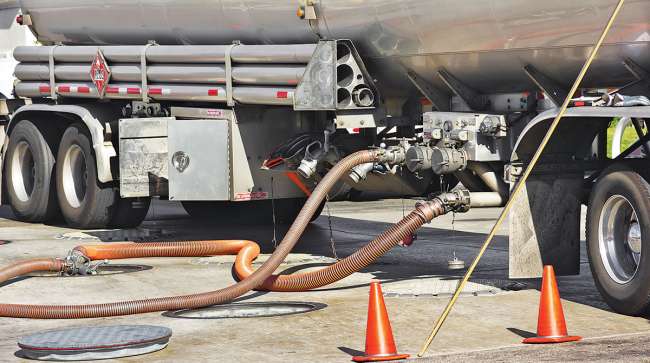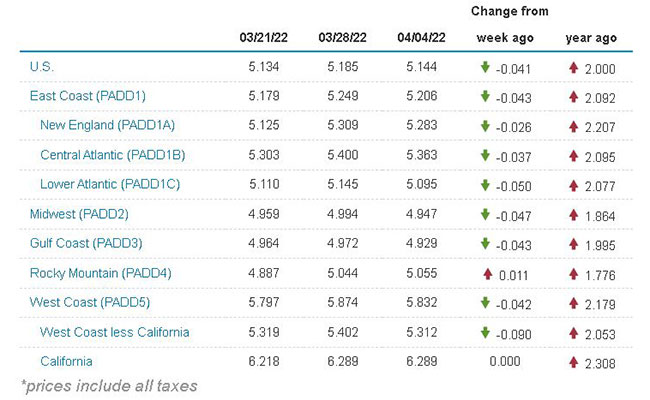Senior Reporter
Diesel Ticks Down 4.1¢ to $5.144 a Gallon

[Stay on top of transportation news: Get TTNews in your inbox.]
Diesel posted a rare downturn as the national average price dropped 4.1 cents to $5.144 a gallon, according to Energy Information Administration data released April 4.
The price of diesel fell for just the second time in the past 13 weeks. The other decline was 11.6 cents March 21.
A gallon of trucking’s main fuel costs $2 more than it did at this time in 2021.
Diesel’s price fell in eight of the 10 regions in EIA’s weekly survey, with the biggest decrease being a nickel in the Lower Atlantic. The price went up 1.1 cents in the Rocky Mountain region and was unchanged in California.
Gasoline also fell in price, sliding 6.1 cents to $4.17 a gallon for the national average.
On-Highway Diesel Fuel Prices

EIA.gov
Oil prices — the key factor behind fuel prices — fell midweek to below $95 following the International Energy Agency’s announcement that U.S. allies will deploy 60 million barrels from stockpiles. President Joe Biden’s administration previously announced a release of 180 million barrels from its own reserves, Bloomberg News reported.
Production of crude oil is well below the high-water mark set in 2019, which was 12.3 million barrels per day, said Susan Grissom, chief industry analyst at American Fuel & Petrochemical Manufacturers, a trade association representing the makers of the fuels and petrochemicals.
“It’s this imbalance between supply and demand, not only in the United States but around the world, combined with larger inflation issues and supply chain challenges, that’s triggered the climb in crude oil,” and hence diesel and gasoline prices, said Grissom.
“And diesel is what fuels the world economy,” she added.
West Texas Intermediate Futures spiked March 6 to $130.50, a 13-year high.
Chevron CEO Mike Wirth said during a recent congressional hearing, “Oil and product prices are correlated over time” with retail prices potentially reflecting costs paid a week or two earlier. “These things do correlate over the long term, but in the short term, they don’t always move in tandem.”

Wirth speaks virtually during a House Energy and Commerce Subcommittee hearing in Washington on April 6. (Al Drago/Bloomberg News)
There is no miraculous and easy solution to correct diesel’s recent massive spike given so many factors at play impacting both supply and demand, said John Auers, executive vice president at Turner, Mason & Co., an energy consultancy.
“Unfortunately, the quickest way for it to be resolved is through severe demand destruction and recession. We are all hoping against that,” he said. “High diesel prices and energy prices overall are a key input in economic growth and performance and we have seen in past recessions they have been a key component in initiating those.”
Grissom and Auers spoke online recently with reporters.
At the same time, the nation is moving into the summer travel season, and usually that is when there is a shift to producing gasoline and away from diesel, Auers said. “In the current environment that’s not going to happen.”
Meanwhile, total gasoline stocks are close to the top of the five-year range. “That really gives the refineries some flexibility in terms of shifting to produce more distillate as needed going forward. At least in the near term,” said Grissom.
EIA reported for the week ending April 1, total stocks of 15 parts per million sulfur and under distillate — used to supply the ultra low sulfur diesel required in commercial trucking — were 104.5 million barrels compared with 133.2 million barrels a year earlier.
Low sulfur distillate inventory dropped the most to 9.5 million barrels compared with 21.6 million a year earlier in the Central Atlantic region — which includes New York, New Jersey, Pennsylvania, Delaware and Maryland, according to EIA.
Diesel is what fuels the world economy.
Susan Grissom, chief industry analyst at American Fuel & Petrochemical Manufacturers
Grissom noted during COVID, six U.S. refineries have either shuttered or begun converting to non-petroleum fuel production.
“While much of the energy security conversation focuses on upstream oil and gas production,” she said, “refining capacity downstream, and the location of that capacity, is critically important; something Americans and our policymakers should not lose sight of.”
Another thing to keep an eye on in terms of product supply is hurricane season, which starts June 1 and runs through November.
“I do think refiners are better prepared since we have had a few tough hurricane seasons over the last two decades,” Auers said. “They are better prepared to meet the challenges of weather than they ever have been, probably.”
Colorado State University issued its annual early April forecast that anticipates an above-average probability for major hurricanes making landfall along the continental United States coastline and in the Caribbean.
CSU estimated there will be nine hurricanes (the average is 7.2), with four of those being major in Category 3, 4 or 5 (the average is 3.2).
A hurricane is defined as having sustained low-level winds of 74 miles per hour or greater.
Want more news? Listen to today's daily briefing below or go here for more info:



